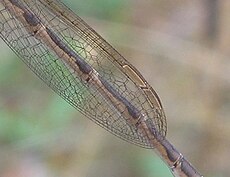
Damselflies are flying insects of the suborder Zygoptera in the order Odonata. They are similar to dragonflies but are usually smaller and have slimmer bodies. Most species fold the wings along the body when at rest, unlike dragonflies which hold the wings flat and away from the body. Damselflies have existed since the Late Jurassic, and are found on every continent except Antarctica.

The red-veined darter or nomad is a dragonfly of the genus Sympetrum.

The Lestidae are a rather small family of cosmopolitan, large-sized, slender damselflies, known commonly as the spreadwings or spread-winged damselflies.

Lestes virens is a species of damselfly in the family Lestidae, the spreadwings. It is known commonly as the small spreadwing or small emerald spreadwing. It is native to much of Europe and western and central Asia.
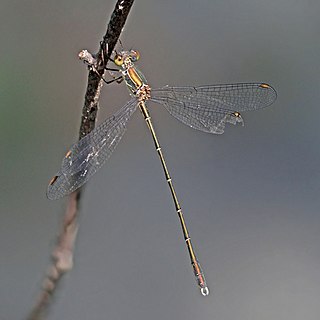
Chalcolestes parvidens, formerly Lestes parvidens, is a damselfly of the family Lestidae. It has a metallic green body and at rest it holds its wings away from its body. Its common name in English is the eastern willow spreadwing.

Lestes rectangularis is a species of damselfly in the family Lestidae, the spreadwings. It is known by the common name slender spreadwing. It is native to eastern North America, including eastern Canada and the United States.
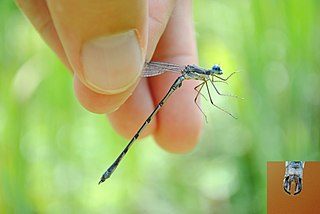
The sweetflag spreadwing is a species of damselfly in the family Lestidae, the spreadwings. It is native to North America, especially eastern parts of Canada and the United States.

Lestes barbarus is a species of damselfly of the family Lestidae, the spreadwings. Its common names in English include southern emerald damselfly, shy emerald damselfly, and migrant spreadwing.
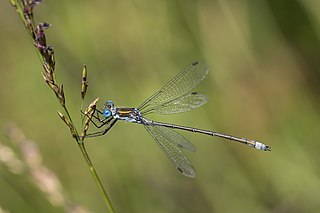
Lestes sponsa is a damselfly with a wide Palaearctic distribution. It is known commonly as the emerald damselfly or common spreadwing. Both males and females have a metallic green colour and brown wing spots. It resides near pools with aquatic plants. When resting its wings are usually half opened.

Lestes dryas is a species of damselfly in the family Lestidae, the spreadwings. Its common names include emerald spreadwing, scarce emerald damselfly and robust spreadwing. An alternate name in Ireland is the turlough spreadwing.

Chalcolestes viridis, formerly Lestes viridis, is a damselfly of the family Lestidae. It has a metallic green body and at rest it holds its wings away from its body. Its common name is the willow emerald damselfly, the green emerald damselfly, or the western willow spreadwing. It has an elongated abdomen and pale brown spots on its wings and resides in areas of still water with overhanging trees.

Lestes congener is a species of damselfly in the family Lestidae, the spreadwings. It is known by the common name spotted spreadwing.

Lestes viridulus, the emerald-striped spreadwing, is a damselfly species in the family Lestidae, the spreadwings. It is native to Bangladesh, India, and Thailand.

Lestes elatus is a species of damselfly in the family Lestidae, the spreadwings. It is known commonly as the emerald spreadwing. It is native to India, Thailand and Sri Lanka.
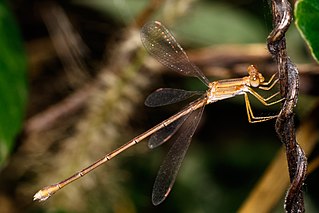
Lestes concinnus is a species of damselfly in the family Lestidae, the spreadwings. They are so named because they rest with their wings spread. This species is known commonly as the dusky spreadwing. It is a nomadic damselfly found in India, Southeast Asia as far as New Caledonia, and northern parts of Australia.

Lestes nodalis is a species of damselfly in the family Lestidae, the spreadwings.

Sympecma paedisca, known generally as siberian winterdamsel, is a species of spreadwing in the damselfly family Lestidae. It is found in Europe.

Platylestes platystylus, the green-eyed spreadwing, is a damselfly species in the family Lestidae. Although this species appears to be widespread, there are very few recent records. This species is known from old records from West Bengal in India, Myanmar, Thailand and Laos. There are recent records from Thailand, Vietnam, Laos and Kerala, South India.




